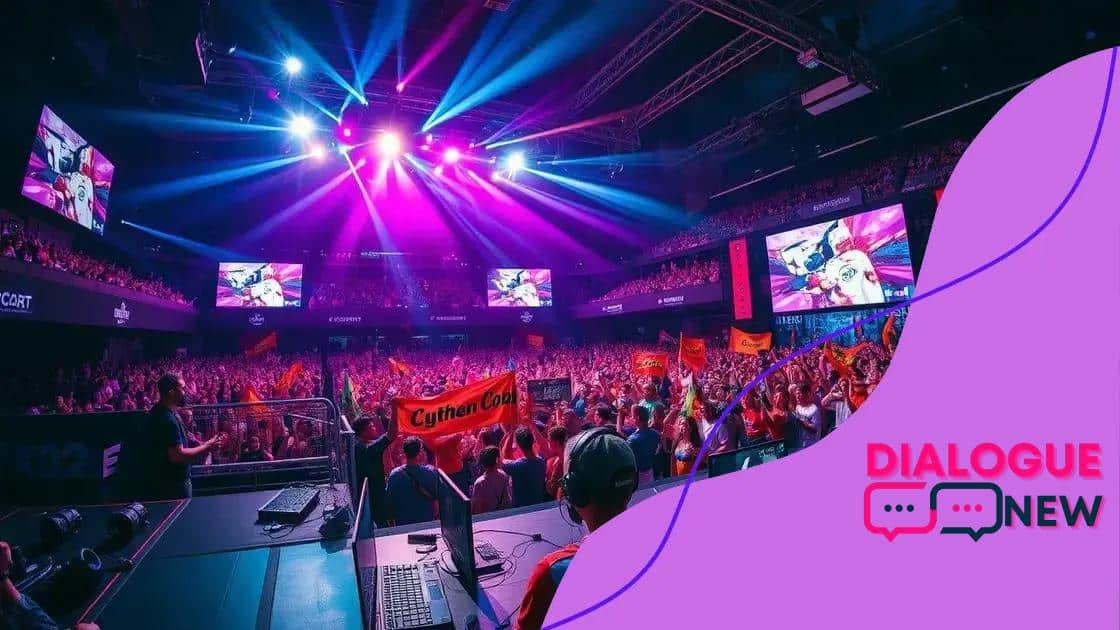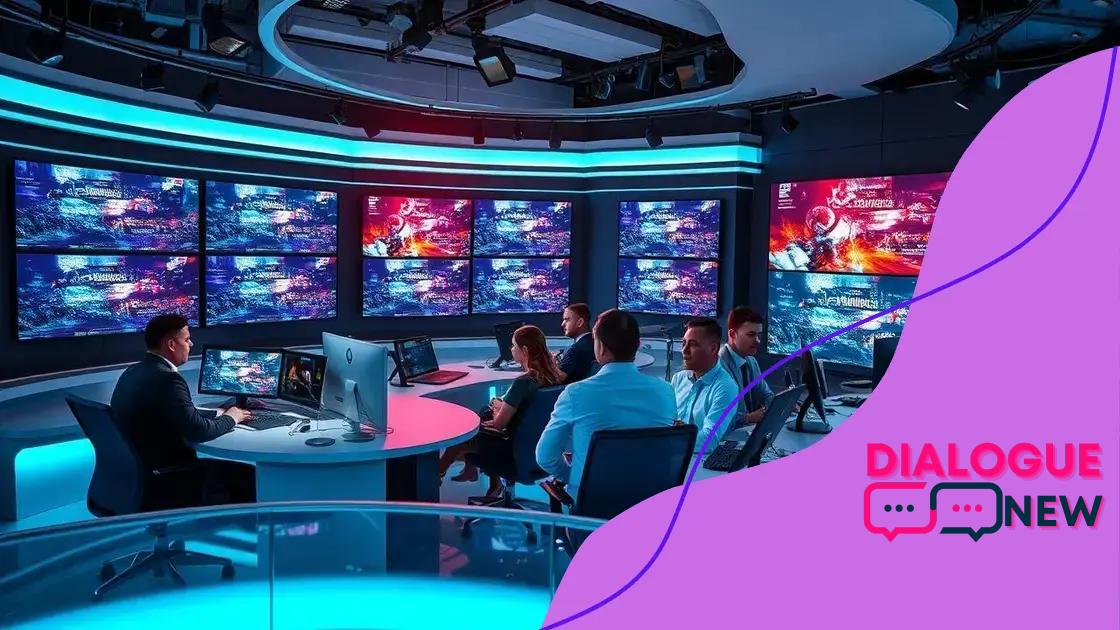How e-sports are influencing mainstream media content

How e-sports are influencing mainstream media content is evident through increased live broadcasts, technology integration, and brand collaborations, driving engagement and capturing younger audiences.
How e-sports are influencing mainstream media content is a fascinating topic worth exploring. Have you noticed how gaming has evolved from niche circles to the forefront of entertainment? Let’s unpack this shift together.
The rise of e-sports in popular culture
The rise of e-sports in popular culture has been nothing short of remarkable. This phenomenon has reshaped how we view entertainment and competition today. More than just games, e-sports bring together diverse audiences and create a vibrant community around gaming.
Factors Contributing to the Growth
Several factors have fueled this explosion in popularity:
- The accessibility of online gaming platforms
- Advancements in streaming technology
- Increased recognition from mainstream media
- Celebrity endorsements and sponsorships
These elements have combined to create a culture where e-sports are not only accepted but celebrated. Major tournaments now draw in millions of viewers, rivaling traditional sports events.
Impact on Youth Culture
For many young people, e-sports have become part of their daily lives. It influences their hobbies, friendships, and even future career aspirations. Schools and colleges are starting to offer e-sports programs, recognizing the skill sets involved in competitive gaming. This shift has made e-sports more mainstream, as students engage with it in academic environments.
Moreover, the sense of community in gaming fosters friendships and connects people from various backgrounds. Gamers often find like-minded friends online, creating a sense of belonging that extends beyond gaming.
Significant Events and Their Influence
Iconic events such as The International or the League of Legends World Championship rank among the most watched annually. These events highlight the skill and dedication of players, turning them into superstars within the community and attracting global audiences. The energy at these events is palpable, bringing fans together to celebrate their favorite teams and players.
As e-sports continue to gain traction, we can expect more collaborations with mainstream brands and a greater presence in traditional media. This intersection of e-sports and broader entertainment culture marks an exciting evolution in how we consume sports.
Impact of e-sports on traditional media platforms
The impact of e-sports on traditional media platforms is significant and growing rapidly. As more viewers turn to gaming competitions, traditional media is adapting to capture this audience.
Integrating E-sports into Broadcasting
Many television networks are now airing e-sports tournaments, recognizing the potential for high viewership and advertising revenue. These broadcasts often attract younger audiences who might not be as engaged with conventional sports.
- Networks like ESPN have dedicated segments for e-sports.
- Streaming platforms like Twitch provide live coverage, drawing millions of viewers.
- Online channels promote interaction and community during events.
- Cross-promotion with popular gamers enhances viewer engagement.
This integration not only garners new fans but also presents traditional sports a challenge to keep up with this digital innovation.
Shifting Advertising Strategies
As e-sports becomes more mainstream, advertisers are discovering unique opportunities. Brands are shifting their strategies to connect with e-sports enthusiasts.
By partnering with popular gaming influencers, companies enhance their reach and visibility in a competitive marketplace. From in-game advertisements to sponsorships of live events, brands are finding effective ways to engage.
These sponsorships showcase their products directly in front of a captivated audience. This not only boosts brand awareness but also builds authenticity by creating relationships within the gaming community.
How mainstream media is adapting to e-sports

As e-sports gain popularity, mainstream media is adapting to this new wave of entertainment. Every year, more viewers tune in to watch competitive gaming, forcing traditional media outlets to rethink their strategies.
Changes in Content Delivery
Media companies are now including e-sports coverage in their programming. This includes live broadcasts, highlight reels, and analyses similar to traditional sports.
- Sports networks are airing e-sports tournaments live.
- Online streaming platforms provide real-time coverage and interaction.
- News segments cover e-sports events just like any traditional sport.
- Documentaries about famous gamers and teams are gaining traction.
This shift in content delivery helps attract younger audiences who prefer digital formats over traditional television.
Collaboration with E-sports Organizations
Many media companies are forming partnerships with e-sports organizations. These collaborations help bridge the gap between traditional sports and gaming culture. By working together, brands and teams can create engaging content that appeals to a broader audience.
Through these partnerships, sponsors can promote their products during live streams, providing seamless integration that feels natural for the viewers. This strategy supports growing e-sports franchises while enhancing brand visibility.
As a result, mainstream media is not just observing from the sidelines but actively participating in the e-sports landscape, shaping its future.
Audience engagement and e-sports events
Engagement with audiences during e-sports events plays a crucial role in the industry’s growth. Gamers and fans alike are not just passive viewers; they actively participate in the excitement and community surrounding these competitions.
Interactive Platforms for Viewing
Platforms like Twitch and YouTube have transformed how fans interact with their favorite games and players. Viewers can chat live during events, send comments, and even donate to their favorite streamers. This level of interaction makes fans feel like part of the action.
- Live chats create engagement among fans.
- Fans can support players through donations and subscriptions.
- Unique emotes and reactions allow viewers to express their excitement.
- Polls and quizzes can be conducted during events for audience participation.
Such features ensure that viewers are not just watching but are involved in real-time experiences.
The Role of Social Media
Social media serves as a powerful tool for enhancing audience engagement. E-sports organizations and players frequently share content, updates, and behind-the-scenes peeks on platforms like Twitter, Instagram, and TikTok. This kind of content helps maintain a connection between events and fans.
Additionally, trending hashtags and challenges on social media create excitement around upcoming tournaments. Fans can rally support for their favorite teams and share their experiences with others, fostering a sense of community.
Each e-sports event becomes a shared cultural moment, drawing in audiences who feel involved and invested in the competition results. This shared experience not only boosts viewership but creates lasting connections between players and fans.
Future trends in e-sports and media synergy
The future trends in e-sports and media synergy are shaping the landscape of entertainment. As technology evolves, both industries are finding new ways to work together, creating exciting opportunities for fans and creators alike.
Increased Use of Virtual Reality
Virtual reality (VR) is set to change how audiences experience e-sports. Fans can immerse themselves in a virtual arena, feeling as if they are part of the action. This technology allows for:
- Real-time interaction with the gaming environment.
- Enhanced viewing experiences that mimic being at live events.
- Opportunities for community engagement within virtual spaces.
- New formats for broadcasting e-sports with XR (extended reality).
As VR becomes more accessible, we can expect a rise in viewer engagement and innovative storytelling alongside competitions.
Integration of AI in Broadcasting
Artificial intelligence (AI) is already playing a role in enhancing how e-sports are produced and viewed. AI technology can analyze games and provide insights that improve broadcasts.
With AI, commentators can access real-time data and statistics, helping them deliver richer narratives during live events. AI-generated highlights can also deliver key moments faster, allowing fans to relive the excitement in just a few minutes.
As the technology advances, we can expect even more personalized viewing experiences catered to individual fan interests.
Collaboration with Brands
The collaboration between e-sports teams and mainstream brands is set to become more strategic. As gamers increasingly become influencers, brands will leverage their reach to connect with younger audiences.
Expect to see more brand placements within games, sponsored content during live streams, and interactive marketing campaigns that resonate with the gaming community. This approach not only enhances brand visibility but also strengthens the relationship between fans and their favorite e-sports personalities.
The future of e-sports and its integration with mainstream media holds great promise. As technology advances, we will witness immersive experiences through virtual reality and enhanced broadcasting using artificial intelligence. The collaboration between brands and e-sports will foster new ways of connecting with audiences. Ultimately, the synergy between e-sports and traditional media will create an engaging landscape that captivates fans and grows the community further.
FAQ – Frequently Asked Questions About E-sports and Media Synergy
How is e-sports changing traditional media?
E-sports is influencing traditional media by incorporating live broadcasts, dedicated segments, and interactive content that attracts younger audiences.
What role does technology play in e-sports events?
Technology enhances e-sports events through immersive experiences like virtual reality and real-time data analytics for better broadcasting.
How do brands benefit from collaborating with e-sports?
Brands gain visibility and connect with younger audiences through strategic partnerships and sponsorships in the e-sports community.
What trends can we expect in the future of e-sports?
Future trends may include increased use of AI, deeper audience engagement through technology, and more innovative brand collaborations.





